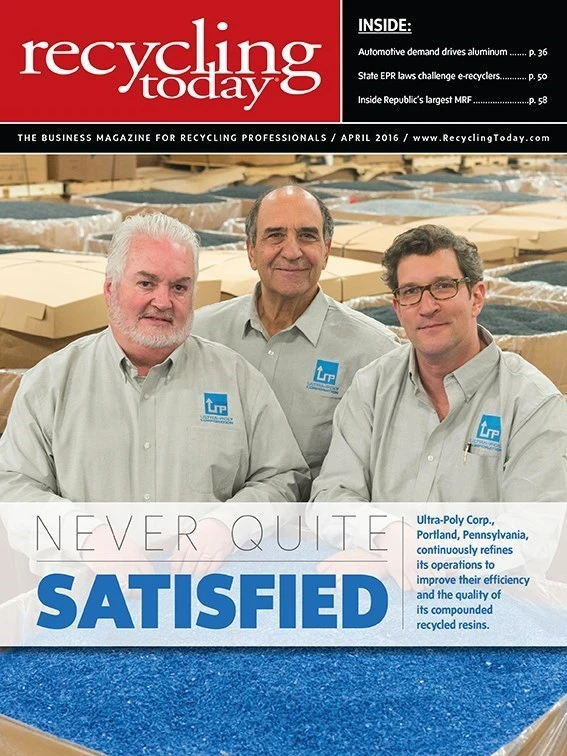Supply and demand factors finally figured in favor of scrap sellers in early March, as prices gained $12 per ton or more, depending on the grade.
The scarcity of scrap, especially obsolete shredder feedstock, pushed prices up from the supply side, while demand for scrap also may have experienced some upward momentum during the March buying period.
Surveyed pricing gathered by American Metal Market (AMM) in early March reflected $12 to $20 price gains in the U.S. Midwest region and a $24-per-ton gain in the East Coast export market. The West Coast export market was the sole laggard, actually falling $12 per ton in March.
Panelists at a session focused on scrap at the Platts Steel Markets North America Conference in mid-March in Chicago offered several reasons for the price rebound.

Considering that China made half of the world’s steel in 2015, steel and ferrous scrap pricing is “all about China—everything else is noise,” said Pete Meyers, a vice president with New Jersey-based Metalico.
Even the Turkish export market, the driver of East Coast export scrap pricing, has been affected by China’s steelmaking overcapacity, he said. Many Turkish rolling mills in 2015 and early 2016 have been buying inexpensive Chinese billet rather than operating their melt shops at full capacity, Meyers noted.
Scrap has begun to close that affordability gap, he said, bringing Turkish buyers back into the market at the same time that U.S. flat-rolled mills are increasing their purchase volumes. “I think it’s safe to say the scrap market is going to get stronger in the next couple of months, but the [higher prices] may not be sustainable,” he cautioned.
Greg Dixon of Kentucky-based Smart Recycling Management said scrap sellers may need to accept that ferrous grades are back in their traditional price range and out of the “totally different range” they inhabited from 2004 to 2013.
“The collection process has, to some extent, broken down because of lower prices. The lower level of the food chain is doing something else.” – Pete Meyers, Metalico
These lower prices have harmed scrap collection infrastructure, he said. “Peddler traffic is a faucet, and it will turn off sometimes.”
Meyers added, “The collection process has, to some extent, broken down because of lower prices. The lower level of the food chain is doing something else. It’s simply not being collected.”
Cleveland-based Joseph Ward of the EMR Group pointed to the demolition sector as another price-sensitive scrap generator. “When plate and structural scrap has a high value, demolition firms will pay to get the job, but not now,” he stated. “Everything is economically driven.”
Rich Brady of OmniSource Corp., which is a subsidiary of Fort Wayne, Indiana-based steel producer Steel Dynamics Inc., said the larger presence of publicly traded companies in the scrap sector has brought with it “different models and philosophies,” including a “focus on inventory turns and near-term financial returns.”
Brady and Ward said regions in the country still have too many shredding plants competing for the same feedstock. Ward added that shredding plants in rural regions may be at a disadvantage because they may not attract scrap from a distance when scale prices are this low.

The good news for shredder operators is that shredded grades in early 2016 have fetched a few dollars per ton more than prime grades, a rare pricing phenomenon. Ward and Dixon said plant operators have improved the quality and chemistry of their shredded grades.
At the same conference, Mario Longhi, president and CEO of United States Steel Corp. (U.S. Steel), said he has had to idle facilities and reduce the size of the workforce. However, he remains optimistic about the company’s future success.
Longhi called 2015 “a year we would like to forget, but we shouldn’t.” He noted that U.S. Steel in 2015 idled some of its facilities, “reduced our workforce at all levels and delayed our electric arc furnace project [in Alabama.] We definitely did not relish making these decisions, but we did what was best in the long-term health of our business.”
On the heels of a new contract with the United Steelworkers Union, Longhi said, “The union has been a true partner in the way we make improvements. The collaboration is incredible.”
Not in spite of but because of the company’s cutbacks, Longhi said there are reasons for optimism. He said U.S. Steel’s internal evaluations found that “at some facilities, 10 percent of our volume was affecting our profitability by 50 percent.” Longhi added, “The pursuit of size is not what the Carnegie Way [initiative] is all about. The sole focus is value driven. We may have to get smaller before we get bigger again.”
Mark Bula, chief commercial officer of Big River Steel (BRS), Osceola, Arkansas, said the startup company’s finishing (annealing and galvanizing) operations will be online by the end of March 2016, while the melt shop is scheduled to ramp up in November 2016.
BRS plans to offer niche and specialty steels for America’s energy grid and other energy and construction applications.

Explore the April 2016 Issue
Check out more from this issue and find your next story to read.
Latest from Recycling Today
- Orion ramping up Rocky Mountain Steel rail line
- Proposed bill would provide ‘regulatory clarity’ for chemical recycling
- Alberta Ag-Plastic pilot program continues, expands with renewed funding
- ReMA urges open intra-North American scrap trade
- Axium awarded by regional organization
- Update: China to introduce steel export quotas
- Thyssenkrupp idles capacity in Europe
- Phoenix Technologies closes Ohio rPET facility





